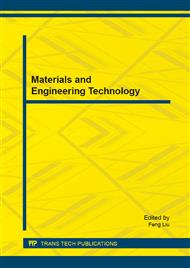[1]
P. Fauchais, Understanding plasma spraying, J. Phys. D: Appl. Phys. 37 (2004) R86-R108.
DOI: 10.1088/0022-3727/37/9/r02
Google Scholar
[2]
P. Fauchais, M. Fukumoto, A. Vardelle, M. Vardelle, Knowledge concerning splat formation: an invited review, J. Thermal. Spray. Technol. 13 (2004) 337-360.
DOI: 10.1361/10599630419670
Google Scholar
[3]
S.H. Leigh, C.K. Lin, C.C. Berndt, Elastic response of thermal spray deposits under indentation tests, J. Am. Ceram. Soc. 80 (1997) 2093-(2099).
DOI: 10.1111/j.1151-2916.1997.tb03093.x
Google Scholar
[4]
F. Tang, J.M. Schoenung, Evolution of Young's modulus of air plasma sprayed yttria-stabilized zirconia in thermally cycled thermal barrier coatings, Scripta Mater. 54 (2006) 1587-1592.
DOI: 10.1016/j.scriptamat.2006.01.021
Google Scholar
[5]
C.J. Li, A. Ohmori, R. Mcpherson, The relationship between microstructure and Young's modulus of thermally sprayed ceramic coatings, J. Mater. Sci. 32 (1997) 997-1004.
Google Scholar
[6]
J. Matejicek, S. Sampath, In situ measurement of residual stresses and elastic moduli in thermal sprayed coatings: Part 1: apparatus and analysis, Acta Mater. 51 (2003) 863-872.
DOI: 10.1016/s1359-6454(02)00478-0
Google Scholar
[7]
T.W. Clyne, S.C. Gill, Residual stresses in thermal spray coatings and their effect on interfacial adhesion: a review of recent work, J. Thermal. Spray. Technol. 5 (1996) 401-418.
DOI: 10.1007/bf02645271
Google Scholar
[8]
J. Matejicek, S. Sampath, Intrinsic residual stresses in single splats produced by thermal spray processes, Acta Mater. 49 (2001) 1993-(1999).
DOI: 10.1016/s1359-6454(01)00099-4
Google Scholar
[9]
J.I. Jang, Estimation of residual stress by instrumented indentation: a review. J. Ceram. Proc. Res. 10 (2009) 391-400.
Google Scholar
[10]
Q. Wang, K. Ozaki, H. Ishikawa, S. Nakano, H. Ogiso, Indentation method to measure the residual stress induced by ion implantation, Nucl. Instr. and Meth. in Phys. Res. B, 242 (2006) 88-92.
DOI: 10.1016/j.nimb.2005.08.008
Google Scholar
[11]
S. Suresh, A.E. Giannakopoulos, A new method for estimating residual stresses by instrumented sharp indentation, Acta Mater. 46 (1998) 5755-5767.
DOI: 10.1016/s1359-6454(98)00226-2
Google Scholar
[12]
E. Frutos, M. Multigner, J.L. G. Carrasco, Novel approaches to determining residual stresses by ultramicroindentation techniques: Application to sandblasted austenitic stainless steel, Acta Mater. 58 (2010) 4191-4198.
DOI: 10.1016/j.actamat.2010.04.010
Google Scholar
[13]
W.C. Oliver, G.M. Pharr, An improved technique for determining hardness and elastic modulus using load and displacement sensing indentation experiments, J. Mater. Res. 7 (1992) 1564-1583.
DOI: 10.1557/jmr.1992.1564
Google Scholar
[14]
N.A. Stilwell, D. Tabor, Elastic recovery of conical indentations, Proc. Phys. Soc. Lond. 78 (1961) 169-179.
DOI: 10.1088/0370-1328/78/2/302
Google Scholar
[15]
B.R. Lawn, V.R. Howes, Elastic recovery at hardness indentations, J. Mater. Sci. 16 (1981) 2745-2752.
DOI: 10.1007/bf02402837
Google Scholar
[16]
J. Alcalά, Instrumented micro-indentation of zirconia ceramics. J. Am. Ceram. Soc. 83 (2000) 1977-(1984).
Google Scholar
[17]
M. Sakai, Energy principle of the indentation-induced inelastic surface deformation and hardness of brittle materials, Acta Metall. Mater. 41 (1993) 1751-1758.
DOI: 10.1016/0956-7151(93)90194-w
Google Scholar
[18]
Y. Bao, L. Liu, Y. Zhou. Assessing the elastic parameters and energy-dissipation capacity of solid materials: A residual indent may tell all. Acta Mater. 53 (2005) 4857-4862.
DOI: 10.1016/j.actamat.2005.06.031
Google Scholar
[19]
J. Matejicek, S. Sampath, P.C. Brand, H.J. Prask, Quenching, thermal and residual stress in plasma sprayed deposits: NiCrAlY and YSZ coatings, Acta Mater. 47 (1999) 607-617.
DOI: 10.1016/s1359-6454(98)00360-7
Google Scholar
[20]
S. Kuroda, T.W. Clyne, The quenching stress in thermally sprayed coatings, Thin Solid Films. 200 (1991) 49-66.
DOI: 10.1016/0040-6090(91)90029-w
Google Scholar


